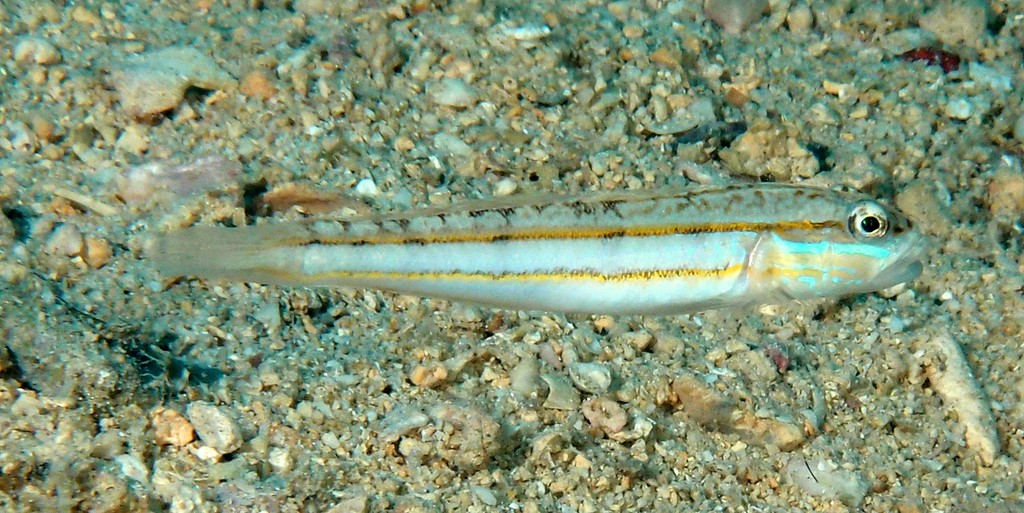VALENCIENNEA PARVA - (HOESE & LARSON, 1994)
Actinopterygii (Gigaclass) > Actinopteri (Class) > Teleostei (Subclass) > Gobiiformes (Order) > Gobioidei (Suborder) > Gobiidae (Family) > Gobiinae (Subfamily) > Valenciennea (Genus)
Gobie nain, Little glidergoby, Little glider goby, Dwarf glidergoby, Little sleeper, Parva goby, Himekuroitohaze, ヒメクロイトハゼ, 小凡塘鱧,
Description
Dorsal spines (total): 6-7, 3rd and 4th spines subequal or 4th slightly longer; Dorsal soft rays (total): 11-13 (usually: 12); Anal spine: 1; Anal soft rays: 12; Pectoral fin rays: 18-20; Gill rakers on inner face of second arch usually: 11-13; Longitudinal scale series: 67-85; Transverse scale count: 17-26; Depth of body: 5.7-6.6 in SL. Pectoral fin base naked; Prepelvic area naked; First dorsal fin low with rounded margin, third to fifth spines subequal or fourth or fifth slightly longer than others; Caudal fin moderately short, with rounded posterior margin. Without filamentous dorsal spines; Ctenoid body scales, becoming cycloid anteriorly below anterior part of first dorsal fin; Without scales on head or midline of nape; Side of nape with scales extending forward slightly anterior to above upper end of gill opening; Scaleless pectoral fin base; Partly scaled or scaleless prepelvic area. Max length: 10.0 cm SL. Depth range: 1 - 20 m.
Color
Greenish gray with two longitudinal, narrow, yellow-orange to dark orange stripes on head and along side of body continuing onto basal half of caudal fin, a narrow black line usually within upper stripe; Both stripes interconnected by a series of indistinct narrow orange bars on body; Nape and dorsal part of body above upper stripe mottled with brown; Head with dark-edged pale blue stripe below level of eye from cheek to posterior margin of opercle and few pale blue spots below the stripe; Dorsal and anal fins with translucent membranes or indistinct pinkish stripe at base of each fin.
Etymology
Valenciennea: in honnor of Achille Valenciennes (1794-1865) who was a French zoologist. He worked with Auguste Henri André Duméril (1812-1870), Georges Cuvier (1769-1832) and Bernard Germain de Lacépède (1756-1825) since 1815. He worked on the 22-volume of a "Histoire naturelle des poissons" (1828-1848), carrying on alone after Georges Cuvier died in 1832.
parva: from Latin, parvus = small, little, dwarf. Referring to its small size.
Original description: Valenciennea parva Hoese & Larson, 1994 - Type locality: Lizard Island lagoon, Queensland, Australia, depth 1-10 meters.
Distribution
Red Sea; Indo-West Pacific: Seychelles, Madagascar and Maldives, east to Samoa, north to Ryukyu Islands (Japan), south to northern Australia and New Caledonia.
Biology
Inhabits coastal and inner reef sand flats and slopes, often in large lagoons. Found normally over clean, medium-grained sand patches interspersed with coral heads. Occurs in pairs or small groups and has been observed in burrows. Monogamous.
Last update: 25, August 2024
Gobie nain, Little glidergoby, Little glider goby, Dwarf glidergoby, Little sleeper, Parva goby, Himekuroitohaze, ヒメクロイトハゼ, 小凡塘鱧,
Description
Dorsal spines (total): 6-7, 3rd and 4th spines subequal or 4th slightly longer; Dorsal soft rays (total): 11-13 (usually: 12); Anal spine: 1; Anal soft rays: 12; Pectoral fin rays: 18-20; Gill rakers on inner face of second arch usually: 11-13; Longitudinal scale series: 67-85; Transverse scale count: 17-26; Depth of body: 5.7-6.6 in SL. Pectoral fin base naked; Prepelvic area naked; First dorsal fin low with rounded margin, third to fifth spines subequal or fourth or fifth slightly longer than others; Caudal fin moderately short, with rounded posterior margin. Without filamentous dorsal spines; Ctenoid body scales, becoming cycloid anteriorly below anterior part of first dorsal fin; Without scales on head or midline of nape; Side of nape with scales extending forward slightly anterior to above upper end of gill opening; Scaleless pectoral fin base; Partly scaled or scaleless prepelvic area. Max length: 10.0 cm SL. Depth range: 1 - 20 m.
Color
Greenish gray with two longitudinal, narrow, yellow-orange to dark orange stripes on head and along side of body continuing onto basal half of caudal fin, a narrow black line usually within upper stripe; Both stripes interconnected by a series of indistinct narrow orange bars on body; Nape and dorsal part of body above upper stripe mottled with brown; Head with dark-edged pale blue stripe below level of eye from cheek to posterior margin of opercle and few pale blue spots below the stripe; Dorsal and anal fins with translucent membranes or indistinct pinkish stripe at base of each fin.
Etymology
Valenciennea: in honnor of Achille Valenciennes (1794-1865) who was a French zoologist. He worked with Auguste Henri André Duméril (1812-1870), Georges Cuvier (1769-1832) and Bernard Germain de Lacépède (1756-1825) since 1815. He worked on the 22-volume of a "Histoire naturelle des poissons" (1828-1848), carrying on alone after Georges Cuvier died in 1832.
parva: from Latin, parvus = small, little, dwarf. Referring to its small size.
Original description: Valenciennea parva Hoese & Larson, 1994 - Type locality: Lizard Island lagoon, Queensland, Australia, depth 1-10 meters.
Distribution
Red Sea; Indo-West Pacific: Seychelles, Madagascar and Maldives, east to Samoa, north to Ryukyu Islands (Japan), south to northern Australia and New Caledonia.
Biology
Inhabits coastal and inner reef sand flats and slopes, often in large lagoons. Found normally over clean, medium-grained sand patches interspersed with coral heads. Occurs in pairs or small groups and has been observed in burrows. Monogamous.
Last update: 25, August 2024
